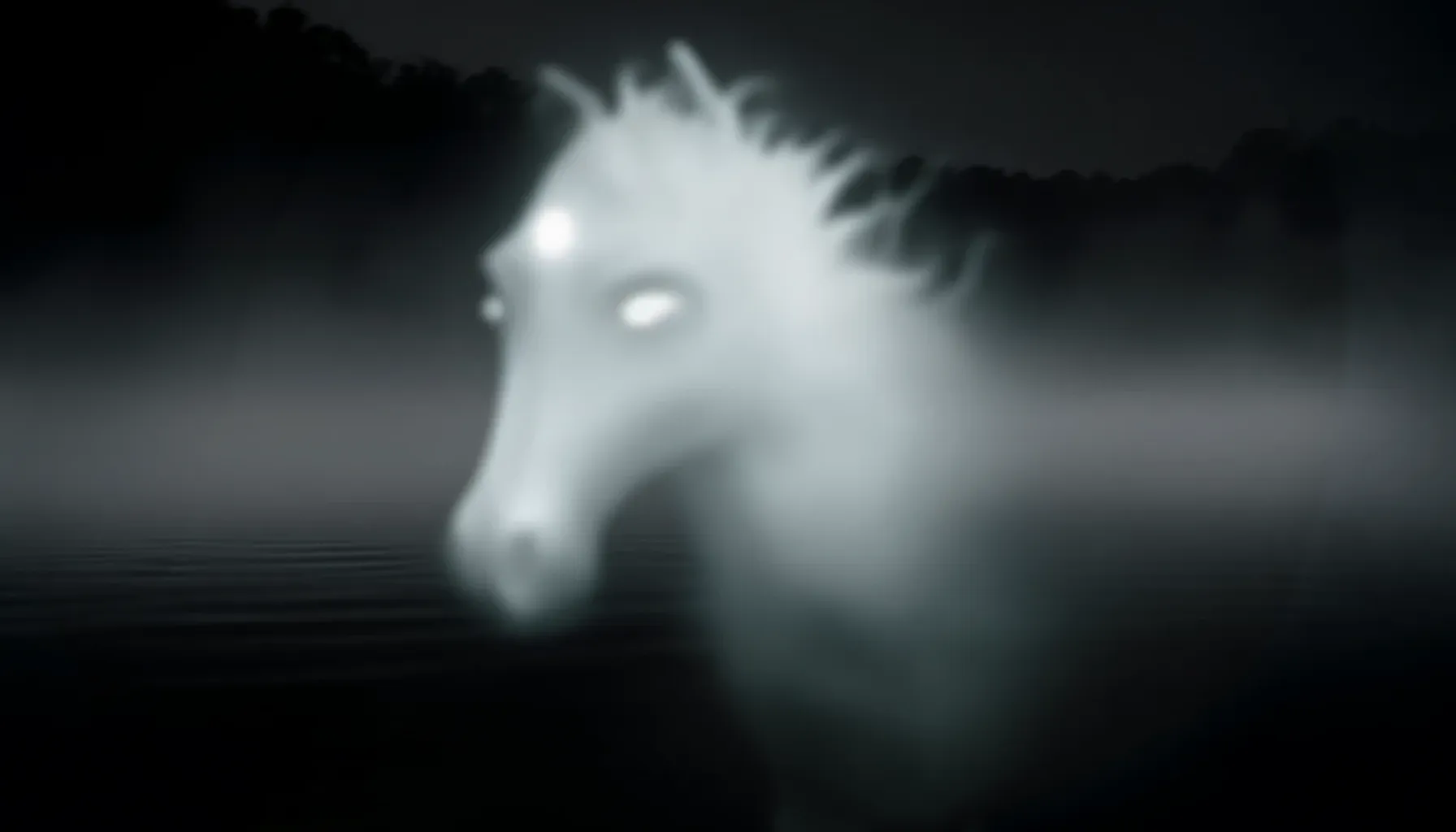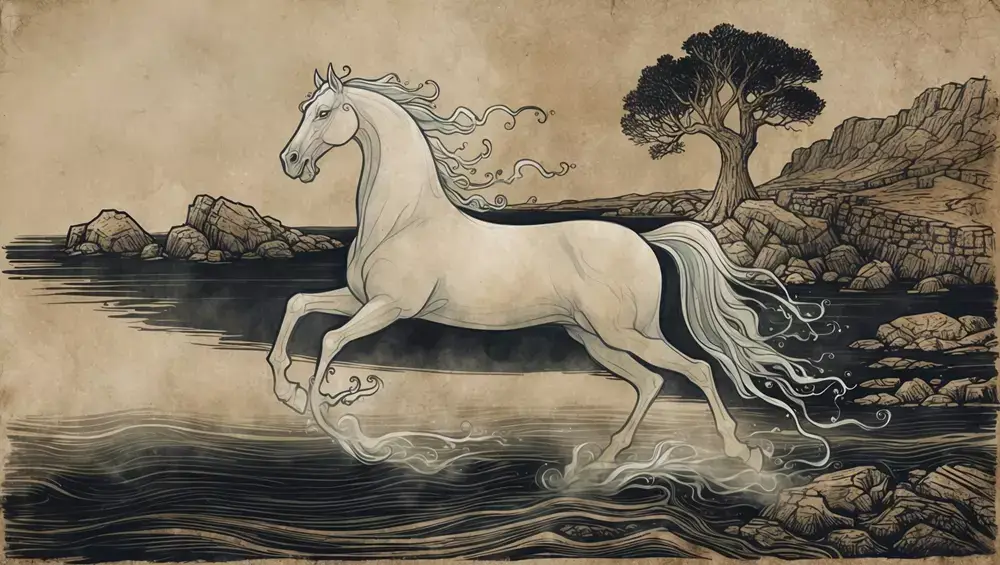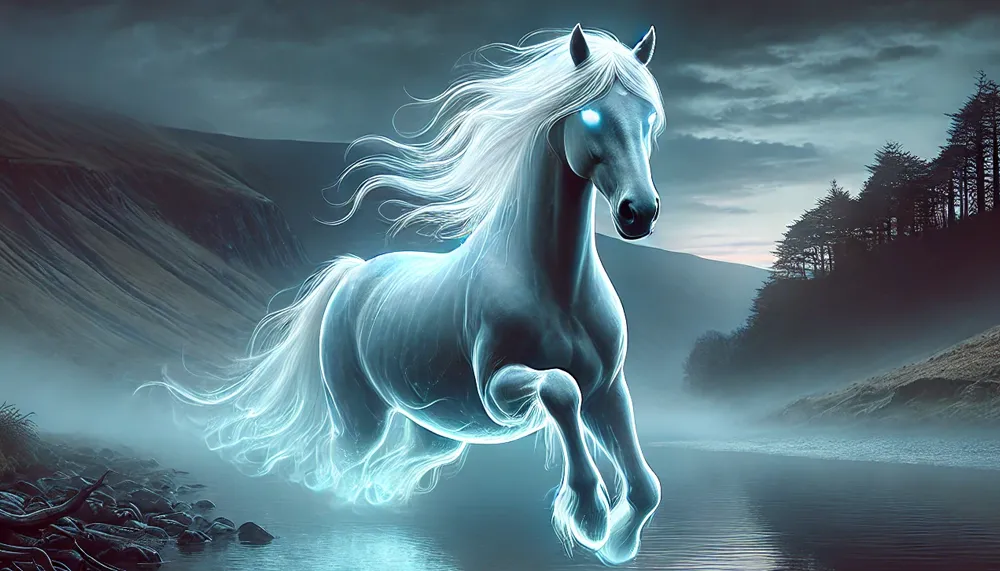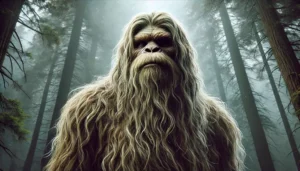Introduction
The Ceffyl Dŵr, a spectral water horse rooted in Welsh mythology, is both alluring and fearsome. Known for its shape-shifting abilities and ethereal form, this creature haunts the remote rivers and mist-laden marshes of Wales. Appearing at first as a graceful horse, it entices travelers and unsuspecting wanderers to mount its back, only to dash wildly into the air or water, vanishing with its rider in a terrifying plunge. This mythological figure is emblematic of the mysterious forces of nature and the perils lurking within.
In Welsh folklore, the Ceffyl Dŵr is deeply connected to the water bodies of the region, embodying the spirit of untamed waterways that once influenced both agriculture and daily life. Unlike similar water horse myths in Celtic and Scottish traditions, such as the kelpie, the Ceffyl Dŵr is more ethereal, often fading away rather than physically attacking its victim. Its elusiveness and supernatural powers cement its place as a symbol of Wales’ dramatic landscape and potent mythology.

History/Origin
The myth of the Ceffyl Dŵr originates from the misty landscapes of Wales, specifically tied to rivers, marshes, and streams that define the region’s geography. Its earliest recorded mentions date back to oral traditions among Welsh communities where storytelling was essential to preserving culture. While written sources are limited due to the oral nature of Welsh myths, Ceffyl Dŵr tales have been passed down over generations, portraying it as an otherworldly creature both alluring and deadly.
“In the sleepy waters of the night, comes the horse of mist, with neither flesh nor form, but clouds that shine at dawn.” The Black Book of Carmarthen (13th century)
Welsh folklore has a unique relationship with water beings. Unlike more aggressive counterparts in Celtic myths, like Scotland’s kelpies, the Ceffyl Dŵr is portrayed as a less corporeal entity. It is often described as a creature of mist and water, a ghostly figure that symbolizes both beauty and danger. Welsh bardic literature and local folklore recount the appearance of the Ceffyl Dŵr as a beautiful horse that seems solid but becomes translucent and elusive as it moves, blending seamlessly with its watery surroundings.
An early record from The Mabinogion, Wales’ collection of medieval tales, provides context for the fascination with supernatural horses. Although the Ceffyl Dŵr itself is not directly mentioned, its kindred spirits—the mystical animals that guide heroes—appear, underscoring the importance of magical beings within Welsh tales. A fragment from a Welsh bard describes a spectral creature: “A form of beauty, swift as shadow, vanishing as the breath of morning…” echoing traits associated with Ceffyl Dŵr.
Another recorded tale speaks of a Ceffyl Dŵr that led a local boy to the edge of a cliff before suddenly dissolving into mist. This tale embodies the belief in the Ceffyl Dŵr as both a protective spirit and a trickster, one that guards the waters while challenging those who would venture too close. With time, the myth has woven into Welsh identity, symbolizing respect for nature’s power and mysteries.
Name Meaning
The name “Ceffyl Dŵr” derives from Welsh, translating to “Water Horse” (with “ceffyl” meaning “horse” and “dŵr” meaning “water”). This direct description underlines the creature’s association with rivers, lakes, and marshlands. The Welsh language, with its deep, poetic nature, reflects in this simple yet evocative name, conveying the essence of a horse not bound to the land but tethered to water.

In the language’s tradition, names often carry layered meanings, so “Ceffyl Dŵr” resonates with images of both beauty and peril. This term encapsulates the dual nature of the beast, which is as much a part of its environment as the rivers and mists it haunts. As Welsh mythology became more documented in the 18th and 19th centuries, “Ceffyl Dŵr” appeared more frequently in collections of Welsh folklore, securing its place in the wider tapestry of water spirit myths across the British Isles.
Background Story
The Ceffyl Dŵr is known for its interactions with unsuspecting humans, typically luring them to a watery or misty end. Many traditional tales recount how the creature appears as a majestic horse grazing near a river or marsh. Attracted by its beauty, travelers often approach, and the Ceffyl Dŵr entices them to mount. Once astride, the creature either leaps into the water, dragging the rider under, or takes to the air in a frantic gallop, ultimately vanishing and leaving its unfortunate victim stranded—or worse, lost forever.
“And a grey horse from the water shall come, in mist and steep places, to guide them from the world’s escape.” (A bardic poem from the 17th century)
In one of the more famous tales, a farmer encountered a Ceffyl Dŵr while traversing a foggy path near a river. Bewitched by its ethereal form, he attempted to capture it, hoping it would serve as a useful steed. However, as he placed a rope around its neck, the creature reared up, dissolving into a thick mist that enveloped him, leaving him disoriented and miles from where he started. In some versions of the myth, the Ceffyl Dŵr serves as a warning sign for dangerous waters, steering those who heed its cues away from harm.
This story illustrates the Ceffyl Dŵr’s dual nature as both guardian and trickster. It does not seek to cause harm overtly but rather challenges those who fail to respect the boundaries of nature. The Ceffyl Dŵr is also associated with the faerie realm, and some believe it can be glimpsed only at twilight or under a full moon. Tales suggest that those pure of heart who encounter the creature may escape unscathed, while others, enticed by greed or arrogance, are lost forever. This moral undertone reflects the creature’s role in Welsh folklore as a symbol of the thin line between human ambition and nature’s untamable spirit.
This complex mythology around the Ceffyl Dŵr has persisted through centuries, blending cautionary tales with respect for the mystery and beauty of Wales’ rivers and marshes. Through these narratives, the Ceffyl Dŵr has come to embody both the danger and allure of the natural world, especially the hidden, mist-cloaked waterscapes of its homeland.
Similar Beings
The Ceffyl Dŵr shares traits with other supernatural water horses from Celtic and Northern European mythology, often reflecting the dual beauty and danger of the natural world:
Kelpie (Scotland): The kelpie is another water spirit with an equine form, known to lure unsuspecting people into rivers or lochs. Unlike the ethereal Ceffyl Dŵr, the kelpie is often described as a more tangible, shape-shifting creature that can turn violent and even devour its victims.
Each Uisge (Ireland and Scotland): Like the kelpie, this water horse also has a dangerous reputation. It is said to have an intense craving for human flesh, dragging victims to watery graves and consuming them, leaving only the liver behind.
Nøkk (Scandinavia): This Norse water spirit also takes on a horse-like form or appears as a beautiful man to lure people into dangerous waters. However, the nøkk can also be a skilled musician, playing hauntingly beautiful music to captivate and ensnare.
Glaistig (Scottish Highlands): This half-woman, half-goat water spirit has similarities to the Ceffyl Dŵr in its elusiveness and association with rivers. Though often benevolent, the glaistig can be protective and even aggressive if disrespected.
These creatures all share an ability to allure humans and evoke both respect and fear of the natural elements they embody, particularly water.
Cultural Impact
The Ceffyl Dŵr has left a lasting impression on Welsh culture and folklore, capturing the mystique of the Welsh landscape with its mist-shrouded mountains and winding rivers. Representing the spirit of wild, untamed waters, the Ceffyl Dŵr serves as a reminder of nature’s beauty and unpredictability. Its legend continues to be woven into storytelling, poetry, and even local festivals, reflecting the Welsh reverence for their environment and the power it holds.
In Welsh poetry and bardic tradition, the Ceffyl Dŵr symbolizes the mist and mystery of Wales’ countryside. Descriptions of ethereal horses and elusive spirits are common, and poets often invoke the image of water-bound beings like the Ceffyl Dŵr to convey themes of fleeting beauty and the peril of human pride in the face of nature. Local storytellers recount tales of the Ceffyl Dŵr to remind people to respect natural bodies of water and approach them with caution.

The Ceffyl Dŵr is sometimes referenced in Welsh festivals that celebrate the country’s natural heritage. For example, in certain Eisteddfod poetry competitions, themes often touch on the mystical aspects of the land, with the Ceffyl Dŵr representing the elusive and mysterious qualities of Welsh folklore. It has become a symbol of cultural pride, inspiring stories that celebrate Wales’ rich and unique mythology, capturing the imagination with visions of a land steeped in mist and mystery.
Religion/Ritual
Although the Ceffyl Dŵr does not have a specific role in organized religion, it is linked to ancient Celtic beliefs in nature spirits and the concept of animism—the belief that natural entities like rivers, trees, and rocks possess a spiritual essence. In this way, the Ceffyl Dŵr can be seen as a guardian of Welsh waterways, a spirit embodying the strength and mystery of water.
People in medieval Wales may have treated rivers and lakes with heightened respect, partially due to the cautionary tales surrounding water spirits. Offerings of flowers or small trinkets were sometimes left by water sources, which may have symbolized a request for safe passage. This practice aligns with Celtic traditions, where offerings were made to appease spirits and secure protection from supernatural forces believed to inhabit natural sites.
Welsh communities also held strong beliefs in the faerie realm, and many considered the Ceffyl Dŵr part of this otherworldly dimension. Sightings of a spectral horse at night or near mist-covered waters were often thought to indicate a connection to faerie lands or an omen, perhaps signaling an individual’s need for greater caution in life. Through these beliefs, the Ceffyl Dŵr became an emblem of both reverence and respect for nature.
Scientific or Rational Explanations
The myth of the Ceffyl Dŵr may have roots in the natural phenomena and landscape of Wales. Mist-covered rivers and lakes often take on an ethereal quality, particularly under moonlight, creating shapes and shadows that could easily be interpreted as ghostly figures. Many believe that the legend of the Ceffyl Dŵr originated from such visual illusions, where the interplay of light, mist, and moving water creates forms that resemble a horse or creature.
There is also a possible connection to real animals seen near Welsh waterways. Wild horses have long roamed Wales, and their sudden appearance in misty or foggy environments could have sparked stories of supernatural creatures. Furthermore, drownings in rivers and lakes were common in ancient times, leading to cautionary tales to dissuade people from wandering too close to the water’s edge, particularly at night.
Another explanation for the Ceffyl Dŵr legend is the psychological phenomenon known as pareidolia, where the human mind perceives familiar shapes in random stimuli, such as mist or shadows. Given the deeply ingrained superstitions and reverence for nature in Celtic culture, such occurrences could easily have been interpreted as supernatural sightings, reinforcing the myth of the spectral water horse.
In Modern Culture
While the Ceffyl Dŵr remains less prominent in popular culture than creatures like the kelpie, it has inspired several modern representations, particularly within Welsh literature, music, and art:
Literature
Welsh authors and poets frequently reference the Ceffyl Dŵr in works that explore local folklore. The Mab by Matt Brown and Eloise Williams, a modern retelling of The Mabinogion, incorporates various Welsh myths, indirectly inspired by the themes surrounding the Ceffyl Dŵr.
Film and Television
The Ceffyl Dŵr makes an appearance in the animated Welsh television series Y Mabinogi, where characters encounter creatures rooted in Welsh folklore. Although depicted briefly, the Ceffyl Dŵr reflects the show’s dedication to Welsh mythology and its surreal, mysterious landscapes.
Video Games
Dark Age of Camelot, a popular online game, includes references to water spirits in Wales, drawing inspiration from the Ceffyl Dŵr to create mystical settings. In the game, characters face creatures inspired by local folklore, embodying the spirit of water-bound, supernatural beings.
Music
The Welsh folk band 9Bach, known for its modern interpretations of Welsh folk songs, has incorporated themes related to the Ceffyl Dŵr in its work. Their haunting melodies and lyrics evoke the misty, mysterious qualities of the creature, blending traditional and contemporary influences to keep Welsh myths alive.
Art
Contemporary Welsh artists often depict the Ceffyl Dŵr as a representation of Welsh culture and its landscapes. Visual artists like Rhiannon Roberts incorporate mystical and supernatural themes, capturing the creature’s elusive form in mist-shrouded river scenes. This artwork continues to bring the myth of the Ceffyl Dŵr to life for modern audiences.
Conclusion
The Ceffyl Dŵr is a profound symbol of Welsh folklore, embodying the natural beauty and hidden dangers of water. Its ghostly form, drifting through misty rivers and marshes, captures the elusive charm and wild spirit of Wales’ landscape. Though not as widely known as similar creatures in Celtic folklore, the Ceffyl Dŵr remains integral to the Welsh cultural imagination, reflecting both respect and caution for the natural world.
Whether seen as a protector of waterways, a trickster, or simply a reminder of nature’s mystery, the Ceffyl Dŵr has endured in the tales of Wales, a spectral guardian and a warning for those who tread too closely to the unknown. This enduring myth reflects humanity’s complex relationship with nature, one that balances beauty, reverence, and the awareness that not all of nature’s mysteries are meant to be understood. Through its legacy, the Ceffyl Dŵr continues to be celebrated as a testament to Welsh heritage, inspiring a blend of respect, awe, and a lingering sense of wonder.










